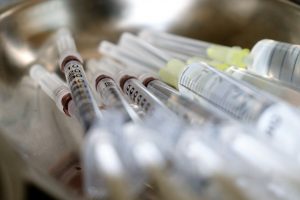Earlier this week, Kyrgyzstan’s Minister of Health Alymkadyr Beishenaliev kicked off the country’s COVID-19 vaccination campaign. Sitting for a shot of the Chinese Sinopharm vaccine, he said, “People said that the minister should experience it. Therefore, I, [and] my deputies, will be vaccinated first.”
Kyrgyz President Sadyr Japarov will reportedly not be getting the vaccine at present. A spokesperson said the president had previously had COVID-19 and blood tests indicated sufficient antibodies.
On March 19, Kyrgyzstan took delivery of 150,000 doses of the Sinopharm COVID-19 vaccine that were provided by China, free of charge. The delivery enabled Kyrgyzstan to begin its vaccination campaign in Bishkek, Osh, and Chui oblast. The first phase is targeting healthcare workers. News site 24.kg reported that “many” healthcare workers refused vaccinations, with Beishenaliev softening that by stating that some had antibodies due to prior infection and thus did not need to be vaccinated. Unaddressed is the potential for vaccine refusal stemming from distrust and disinformation, rather than prior infection.
The gifted 150,000 doses will be enough for 75,000 people to be vaccinated. While it’s a start, Kyrgyzstan’s population exceeds 6.4 million.
Kyrgyzstan has been allocated 2.6 million vaccine doses (up from an initial allotment of 1.2 million) via the World Health Organization’s COVAX initiative, but getting them has not been a simple matter. Bishkek was first offered the Pfizer vaccine but logistical issues related to the super-cold storage requirements of the vaccine proved a problem.
According to Beishenaliev, Kyrgyzstan was then offered the AstraZeneca vaccine, which was supposed to be delivered in March, but that dovetailed disastrously with concerns arising in Europe over the vaccine’s potential link to deadly blood clots. Europe is still sorting out whether blood clots in individuals who had received the AstraZeneca vaccine are related to the vaccine or not, and Kyrgyz health authorities seem to be waiting on that verdict before proceeding.
Beishenaliev noted that Kyrgyzstan is also waiting on a delivery of Russia’s Sputnik V vaccine, commenting that he believes that will come in May-June.
Kyrgyzstan appears to be the fourth country in Central Asia to begin its vaccination drive. So far, it’s the only state in the region to begin with a Chinese-made vaccine.
Uzbekistan triumphantly approved the Chinese Zhifei Longcom Biopharmaceutical vaccine, for which it has been hosting phase 3 trials, for use early in March. But the country is now reported to be beginning its mass vaccination campaign on April 1 with AstraZeneca doses received, free of charge, via COVAX. According to Reuters, Uzbekistan received its first 660,000-dose batch of the AstraZeneca vaccine in mid-March and is waiting to received 1.5 million more doses. Uzbekistan continues to negotiate with Russia for 1 million doses of Sputnik V (down from a reported order of 35 million last September).
As for the Zhifei Longcom Biopharmaceutical vaccine, under the local name ZF-UZ-VAC 2001, Uzbekistan reportedly took delivery from China of 1 million doses this week. Uzbekistan and China reportedly signed a nondisclosure agreement on the price.
Tajikistan apparently began its vaccination campaign on March 23 with AstraZeneca doses provided, free of charge, via COVAX. Curiously, the UNICEF representative in Tajikistan, Osama Makkawi Khogali, was reported as the first person to receive the vaccine — not a Tajik government official or citizen. Tajikistan took delivery of 192,000 doses of the AstraZeneca vaccine in early March. The country claims to not have registered any new cases of COVID-19 since early January.
Kazakhstan and Turkmenistan both began their vaccination campaigns in February with Russia’s Sputnik V. While Turkmenistan made no official announcement (just as it has never confirmed any COVID-19 cases), RFE/RL reported the campaign as beginning in February. There’s more information available for how the campaign is going in Kazakhstan, with Eurasianet reporting on March 11 that it was proceeding at a “snail’s pace.” Of the 100,000 people Nur-Sultan had hopped to vaccinate in February, less than 40,000 had received their first shot as of early March.
While it’s tempting to apply a geopolitical lens to the matter of vaccine distribution, the primary reality is that countries take what they can get fastest. China’s provision of free doses to Kyrgyzstan is certainly interesting in light of its NDA with Uzbekistan over the price of vaccines sold to Tashkent. Furthermore, each country in Central Asia is going to have to source vaccines from multiple suppliers even in the best case scenario in order to cover their entire populations. Uzbekistan’s challenge is the greatest in this regard; with the region’s largest population — over 33.6 million — it will need every avenue for vaccines it can open. Lastly, supply is just a logistical issue. The largest hurdles will be the social barriers — hesitancy due to distrust or the belief that prior infection is good enough protection.

































